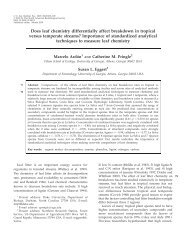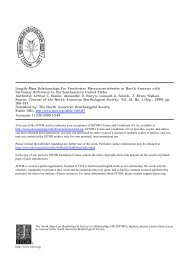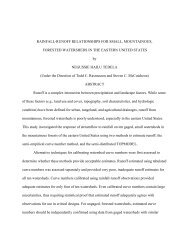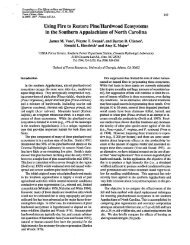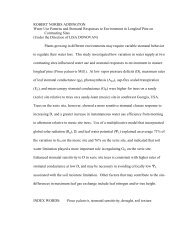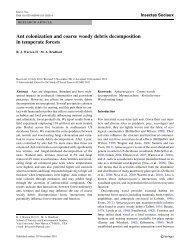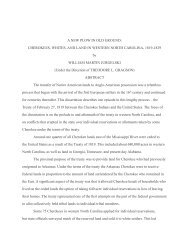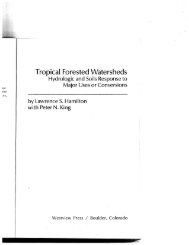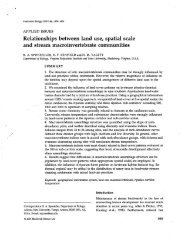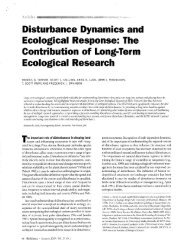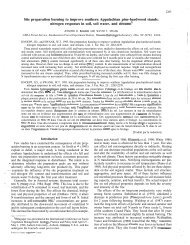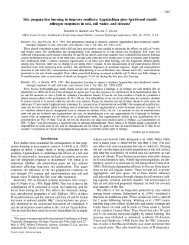biology join - Coweeta LTER - University of Georgia
biology join - Coweeta LTER - University of Georgia
biology join - Coweeta LTER - University of Georgia
Create successful ePaper yourself
Turn your PDF publications into a flip-book with our unique Google optimized e-Paper software.
Articles<br />
to climate oscillation variables that were significant at<br />
a < .10 in the models (table S2).<br />
The cool-season (November–April) and warm-season<br />
(May–October) streamflow values were significantly correlated<br />
with at least one climate index or interaction term<br />
at all sites except FRA, KNZ, NWT, and PIE (table S2).<br />
Significant correlations <strong>of</strong> streamflow were more frequent<br />
with ENSO (11, plus six interactions) and PDO (10, plus<br />
one interaction) than with NAO (4, plus six interactions)<br />
(table S2). Significant correlations were also slightly more<br />
frequent in winter (18) than in summer (14). These findings<br />
extend Greenland and colleagues’ (2003) analysis <strong>of</strong> climate<br />
indices, temperature, and precipitation at US <strong>LTER</strong> Network<br />
sites and corroborate the results <strong>of</strong> other studies. Molles<br />
and Dahm (1990) noted that streamflow in two rivers in<br />
New Mexico was significantly higher during El Niño (warm<br />
sea-surface temperatures in the eastern Pacific) than during<br />
La Niña conditions. Cayan and colleagues (1999) showed<br />
that days with high daily precipitation and streamflow<br />
were more frequent than average in the US Southwest and<br />
less frequent in the Northwest during El Niño by examining<br />
effects on snowpack accumulation and the subsequent<br />
melt. Enfield and colleagues (2001) found that sea-surface<br />
temperatures in the northern Atlantic are correlated with<br />
those in the northern Pacific and are associated with variations<br />
in streamflow in the Mississippi River and in Florida.<br />
Sea-surface temperature and pressure anomalies originating<br />
in the North Pacific affect cyclonic circulation over the East<br />
Coast and summer precipitation, streamflow, and drought<br />
(Barlow et al. 2001).<br />
These findings underscore the importance <strong>of</strong> separating<br />
the effects on streamflow <strong>of</strong> climate variability from longterm<br />
trends. Because the ENSO oscillation has a wavelength<br />
<strong>of</strong> 2–7 years, trends in climate and streamflow data sets over<br />
fewer than 20 years may simply reflect ENSO. Similarly, the<br />
PDO has a wavelength <strong>of</strong> 4–16 years (MacDonald et al. 2005),<br />
with mostly negative PDO in the 1950s to the mid-1970s<br />
and mostly positive PDO from 1976 to 1998. The NAO was<br />
predominantly negative between the 1950s and the early<br />
1970s and was mostly positive between the 1980s and the<br />
early 1990s. As a result, climate and streamflow trends from<br />
the 1950s to 2000 may be strongly affected by these climate<br />
oscillations. For example, at ARC, streamflow increased<br />
between 1988 and 2003, but declined between 1988 and 2008,<br />
so lengthening the record shifted the direction <strong>of</strong> apparent<br />
change. The lack <strong>of</strong> statistically significant increases in<br />
minimum temperature at the tundra ARC and boreal forest<br />
LVW sites (see the next section) may also be attributed to<br />
confounding effects <strong>of</strong> climate oscillations on these relatively<br />
short-term records.<br />
Climate oscillations influence ecosystem processes<br />
through streamflow and moisture. Streamflow was slightly<br />
more weakly correlated to climate indices in summer than<br />
in winter, perhaps because precipitation and streamflow are<br />
more closely related when ecosystems are dormant. ENSO<br />
is linked to aquatic-community structure in the Southwest<br />
(Sponseller et al. 2010), PDO is related to salmon returns<br />
in the Northwest (Mantua et al. 1997), and NAO is linked<br />
to stream salamander abundance in the Southeast (Warren<br />
and Bradford 2010). Headwater streamflow records are<br />
just beginning to be long enough to relate climate variability<br />
and trends to ecosystem processes and population<br />
dynamics.<br />
Climate and streamflow trends at long-term<br />
headwater basin study sites<br />
Nineteen sites had long-term records suitable for testing<br />
trends in T, P, and Q (table S1). Sites were included in the<br />
analysis if they had overlapping records <strong>of</strong> T, P, and Q<br />
that exceeded 20 years. The climate and streamflow record<br />
lengths used for trend estimation ranged from 20 to just<br />
over 60 years; five were 20–30 years; one was 30–40 years;<br />
four were 40–50 years; seven were 50–60 years; and two<br />
were more than 60 years (table S1). The records exceeding<br />
40 years are from USGS gauges and nearby climate stations<br />
(CAP, GCE, JRN, OLY, SBC, SEV), USFS EFRs that became<br />
US <strong>LTER</strong> Network sites (AND, CWT, HBR), other <strong>LTER</strong><br />
Network sites (HFR), and USFS EFRs (FER, MAR) that<br />
did not become <strong>LTER</strong> Network sites. The records less than<br />
40 years in length were USGS gauges and nearby climate<br />
stations at <strong>LTER</strong> Network sites, WEBB sites, and EFRs (ARC,<br />
FRA, LUQ, LVW, NTL, and NWT).<br />
Interannual trends in minimum and maximum daily T,<br />
P, Q, and run<strong>of</strong>f ratios (Q:P) were estimated using linear<br />
regression and the Mann–Kendall nonparametric trend test<br />
(Helsel and Hirsch 2002). In these analyses, we used the<br />
period <strong>of</strong> record or from 1950 onward. Linear regressions<br />
and Mann–Kendall tests produced almost identical results<br />
(Hatcher 2011). The water year was defined as 1 October to<br />
30 September. Tests were conducted using daily data. The<br />
daily P and Q values were log transformed before analysis.<br />
Data were tested for autocorrelation before analysis, and<br />
residuals from linear regression analyses were also tested<br />
for autocorrelation. Significant trends in annual T, P, and Q<br />
were defined as 10 or more days (out <strong>of</strong> 365) with significant<br />
trends (at a � .025) and no autocorrelation before regression<br />
or in the residuals, and an average slope <strong>of</strong> the trend in<br />
daily values exceeding its standard error.<br />
Annual minimum or maximum daily temperature<br />
increased significantly at 17 <strong>of</strong> the 19 sites (minimum temperatures<br />
increased at 13 sites and maximum temperatures<br />
increased at 7 sites), but only two sites experienced significant<br />
changes in precipitation over the period <strong>of</strong> available<br />
record (figure 6). Minimum daily temperatures increased by<br />
several degrees Celsius since 1980 at NWT and FRA, highelevation,<br />
snow-dominated sites in the Rocky Mountains,<br />
but not at the other high-elevation Rocky Mountain site<br />
(LVW). Minimum daily temperature also increased by several<br />
degrees Celsius since the 1950s at climate stations near<br />
JRN and SEV in New Mexico, since the 1950s at a southeastern<br />
temperate forest site (CWT), and since the 1960s<br />
at a northern hardwood site (MAR) but not at its neighbor<br />
396 BioScience • April 2012 / Vol. 62 No. 4 www.biosciencemag.org



